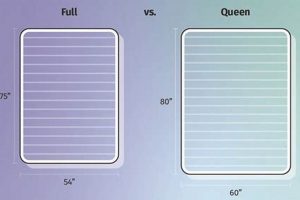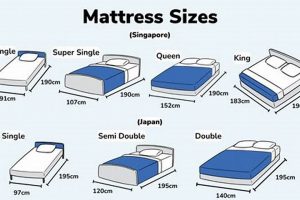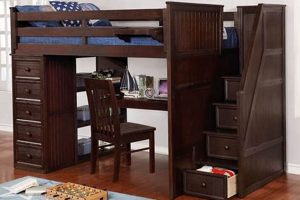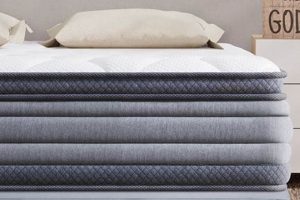The comparative analysis of bed sizes, specifically those around the standard “double,” reveals distinctions crucial for informed consumer choices. Often used interchangeably, these terms describe a mattress intended for one to two occupants, with dimensions that offer a balance between space efficiency and sleeping comfort. For example, an individual seeking a bed for a small guest room or a single sleeper who desires more room than a twin might consider this size category.
Understanding the nuances of mattress sizing is beneficial in several ways. It affects the overall layout and functionality of a bedroom, influencing decisions about other furniture placement. Furthermore, selecting the appropriately sized sleep surface contributes directly to sleep quality, impacting physical and mental well-being. Historically, these bed dimensions evolved to accommodate the changing living spaces and economic factors of diverse populations, reflecting a demand for practicality and comfort.
The subsequent discussion will delve into the specific measurements, suitability for different users, and associated considerations when choosing between these similar, yet distinct, sleep solutions. This examination will encompass factors like room size, sleeper habits, and budget constraints to provide a comprehensive guide for making the optimal selection.
Selection Guidance
This section offers specific guidance for consumers navigating the options associated with choosing a sleep surface of this size. Consideration of individual needs and spatial constraints is paramount.
Tip 1: Measure the Available Space: Accurately measure the bedroom dimensions to ensure the chosen mattress fits comfortably, allowing for adequate movement and placement of other furniture. Consider door swing and closet access when planning the layout.
Tip 2: Evaluate Sleeper Size and Habits: Assess the number of sleepers and their respective sizes. Individuals sharing the bed require sufficient space to avoid sleep disruption. Consider sleeping styles, such as whether one sleeper tends to move frequently during the night.
Tip 3: Research Mattress Types: Explore different mattress types, including innerspring, memory foam, latex, and hybrid options. Each type offers unique benefits in terms of support, comfort, and temperature regulation. Research the specific characteristics of each type and consider personal preferences.
Tip 4: Consider Foundation Compatibility: Ensure the chosen mattress is compatible with the existing or intended bed foundation. Different mattress types may require specific foundation types for optimal support and longevity. Verify compatibility guidelines before purchase.
Tip 5: Read Reviews and Compare Prices: Research customer reviews and compare prices from multiple retailers. Reviews can provide valuable insights into the real-world performance and durability of different mattress models. Price comparison ensures the best value for the investment.
Tip 6: Check Warranty and Return Policies: Thoroughly review the manufacturer’s warranty and the retailer’s return policy. A comprehensive warranty protects against manufacturing defects, while a flexible return policy allows for a trial period to assess comfort and suitability.
Careful attention to these guidelines facilitates an informed decision, maximizing sleep quality and overall satisfaction.
The concluding sections will summarize the key factors to consider, further solidifying the knowledge required to select the optimal sleep solution.
1. Dimensions
The dimensions of a mattress fundamentally define its classification as a “double” or “full.” These measurements directly dictate the surface area available for sleep. A standard double mattress measures approximately 54 inches wide and 75 inches long. In contrast, mattresses of other sizes deviate from these standard measurements. This difference in width, while seemingly minor, can significantly impact the comfort of two adults sharing the sleep surface. For instance, each adult sleeping on a “double” has approximately 27 inches of personal space horizontallyless than the width of a crib mattress. This lack of space can lead to disrupted sleep patterns due to movement or temperature regulation issues.
Understanding these dimensions has practical applications in bedroom design and furniture selection. Small apartments or guest rooms often necessitate careful consideration of mattress size to maximize usable space. For example, selecting a larger bed in a compact room may impede circulation and limit storage options. Moreover, the specific dimensions of a mattress affect the selection of appropriately sized bed frames, linens, and other accessories. A full-sized sheet set will not properly fit a queen-sized mattress, highlighting the direct correlation between dimensions and practical utility.
Accurate comprehension of mattress dimensions allows consumers to make informed purchasing decisions, optimizing both comfort and spatial efficiency. The difference between the nominal sizes translates directly to the quality of sleep and suitability for the intended use case. A misjudgment in size can lead to dissatisfaction, highlighting the need for careful assessment prior to purchase.
2. Room Size
The correlation between room size and bed dimensions represents a critical factor in bedroom design and functionality. The available square footage dictates the practicality of accommodating different bed sizes. Selecting the incorrect mattress size can lead to spatial constraints, impeding movement and limiting furniture placement. For instance, a smaller bedroom, approximately 10 feet by 10 feet, may feel cramped with a double bed, whereas a larger bedroom, 12 feet by 14 feet, provides sufficient space for comfortable accommodation. The consequences of disregarding room size include reduced living space, compromised aesthetics, and decreased usability.
Real-world examples illustrate the significance of this relationship. In urban apartments where space is a premium, residents often prioritize functionality over bed size, opting for smaller mattresses to maximize living area. Conversely, in suburban homes with larger bedrooms, occupants may select larger beds to enhance comfort and aesthetics. The practical significance of understanding the room size-bed size connection lies in optimizing bedroom ergonomics and creating a balanced living environment. Proper space planning ensures ease of navigation, adequate storage, and an overall sense of spaciousness.
In summary, the interplay between room size and mattress dimensions represents a fundamental aspect of interior design. Careful consideration of spatial limitations and personal preferences is essential for creating a functional and aesthetically pleasing bedroom. Disregarding this relationship can result in spatial inefficiencies and compromised living conditions. Ultimately, successful bedroom design necessitates a harmonious balance between room size, furniture selection, and individual needs, ensuring a comfortable and inviting sleeping environment.
3. Sleeper Number
The number of individuals intended to occupy a bed directly influences the suitability of a “double” or “full” mattress. Considering this factor is paramount to ensure adequate sleep quality and minimize disturbances.
- Single Occupancy Comfort
For a single sleeper, either mattress size provides ample space to stretch and move during sleep. Personal preference regarding spaciousness dictates the optimal choice. A larger individual may prefer the “double” for unrestricted movement, while a smaller person might find it excessive.
- Dual Occupancy Limitations
When accommodating two sleepers, limitations become apparent. The width of a “double” mattress allocates approximately 27 inches per person, a significantly smaller space than a standard twin bed. This restricted area can lead to discomfort, disrupted sleep due to movement, and increased body temperature, negatively impacting sleep quality.
- Impact on Sleep Quality
Sleep studies demonstrate a correlation between bed size and sleep disturbance among couples. Smaller beds, such as a “double,” can exacerbate existing sleep problems, including restlessness and snoring. The limited space restricts individual movement, causing disturbances for the co-sleeper and reducing overall sleep efficiency.
- Considerations for Children
A “double” mattress may accommodate two young children comfortably. However, as children grow, the limitations of the bed become more apparent. The duration for which a “double” is suitable for multiple children depends largely on their individual growth rates and tolerance for restricted space.
Evaluating the intended number of sleepers is a critical component of mattress selection. While a “double” may suffice for single occupancy or temporary dual occupancy, long-term co-sleeping generally necessitates a larger mattress size to ensure adequate comfort and minimize sleep disturbances.
4. Price Range
The cost associated with acquiring a sleep surface is a significant factor in consumer decision-making. The budgetary considerations applicable to purchasing decisions for a “double” or “full” mattress influence the range of options available and the overall value proposition.
- Material Composition and Cost
The materials used in the construction of a mattress directly impact its price. Innerspring mattresses, often considered entry-level options, generally possess lower price points compared to memory foam or latex mattresses. Hybrid models, incorporating a combination of materials, typically fall within a mid-range price category. The quality and density of these materials further influence the overall cost.
- Brand Reputation and Pricing Strategy
Established mattress brands often command premium prices due to perceived quality, durability, and customer service. These brands invest significantly in marketing and research and development, which contributes to their pricing strategies. Conversely, lesser-known or direct-to-consumer brands may offer similar products at more competitive price points by reducing overhead costs.
- Construction Complexity and Labor Costs
The intricacy of the mattress design and manufacturing process contributes to the final cost. Hand-tufted mattresses, for example, require skilled labor and are typically more expensive than mass-produced models. Similarly, mattresses with specialized features, such as zoned support systems or advanced cooling technologies, incur higher production costs.
- Retailer Markups and Sales Events
The retail channel through which a mattress is purchased influences its final price. Brick-and-mortar stores often have higher overhead costs compared to online retailers, resulting in higher markups. Seasonal sales events, such as Black Friday or Memorial Day, can provide opportunities to acquire mattresses at discounted prices, impacting the overall value proposition.
Ultimately, the price range associated with mattresses reflects a complex interplay of material costs, brand positioning, manufacturing processes, and retail strategies. Consumers must carefully weigh these factors against their budgetary constraints and prioritize features that align with their individual needs and preferences when selecting a sleep surface.
5. Bedding Fit
The compatibility of bedding with mattress dimensions constitutes a fundamental aspect of overall sleep comfort and aesthetic presentation. Proper bedding fit ensures optimal functionality, longevity, and a visually appealing arrangement of the sleeping area. The relationship between bedding and mattress size directly impacts the user experience, influencing factors such as ease of maintenance and thermal regulation.
- Sheet Dimensions and Mattress Depth
The dimensions of fitted and flat sheets must align with the mattress size to ensure secure placement and prevent slippage. Insufficient sheet depth results in the sheet detaching from the mattress corners, compromising comfort and aesthetics. Conversely, excessive sheet depth creates wrinkles and bunching, also negatively affecting sleep quality. A double or full mattress typically requires sheets specifically designed for these dimensions, accounting for standard mattress depths, which can vary. The increasing prevalence of thicker mattresses necessitates consideration of sheet pocket depth during purchase.
- Duvet and Comforter Size
The size of a duvet or comforter should correspond to the mattress dimensions to provide adequate coverage and thermal insulation. An undersized duvet fails to cover the entire mattress surface, resulting in uneven temperature distribution and diminished aesthetic appeal. An oversized duvet, while offering enhanced warmth, may drape excessively, creating a cumbersome and visually unbalanced appearance. Selecting a duvet or comforter specifically designed for a double or full mattress ensures optimal coverage and thermal efficiency.
- Pillow Placement and Bedding Aesthetics
The number and arrangement of pillows contribute significantly to the overall aesthetic of the bedding ensemble. Standard pillows typically measure 20 inches by 26 inches, and two pillows placed side-by-side generally fit appropriately across the width of a double or full mattress. However, larger pillows or multiple rows of pillows may overwhelm the available space, disrupting the visual balance and potentially compromising sleeping comfort. Careful consideration of pillow size, quantity, and arrangement enhances the overall aesthetic appeal of the bedding ensemble.
- Bed Skirt Considerations
A bed skirt, also known as a dust ruffle, serves both functional and decorative purposes. It conceals the bed frame and under-bed storage while adding a touch of elegance to the bedroom decor. The drop length of the bed skirt, the distance from the top of the bed frame to the floor, must correspond to the height of the bed frame to ensure proper coverage and prevent dragging on the floor. Selecting a bed skirt specifically designed for a double or full mattress ensures a tailored and aesthetically pleasing appearance.
- Mattress Protector/Topper Fit
Mattress protectors and toppers add an additional layer of cushioning and protect the mattress from stains and wear. Selecting a mattress protector/topper that precisely fits the dimensions of the double/full mattress is vital to ensure full mattress protection and comfort. An ill-fitting mattress protector/topper can bunch up and create discomfort during sleep and fail to protect the edges.
In summary, attention to bedding fit enhances both the functionality and aesthetics of a double or full mattress. Selecting bedding that aligns with the specific dimensions of the mattress ensures optimal comfort, longevity, and a visually appealing sleeping environment. Neglecting this aspect can result in discomfort, diminished aesthetic appeal, and reduced bedding lifespan.
Frequently Asked Questions
The following questions address common concerns and misconceptions regarding mattress sizing, specifically focusing on the distinction between “double” and “full” dimensions. This section provides concise answers to aid in informed decision-making.
Question 1: Are “double” and “full” mattresses the same size?
While often used interchangeably, “double” and “full” generally refer to the same standard mattress size: approximately 54 inches wide and 75 inches long. Terminology may vary by region or retailer.
Question 2: Is a “double” mattress suitable for two adults?
A “double” mattress may accommodate two adults, but the limited width (approximately 27 inches per person) can compromise sleep quality due to restricted space and potential disturbances.
Question 3: What room size is recommended for a “double” mattress?
A room size of at least 10 feet by 10 feet is generally recommended to comfortably accommodate a “double” mattress, allowing for adequate movement and furniture placement.
Question 4: What is the typical price range for a “double” mattress?
The price range varies depending on the material, brand, and retailer. Generally, prices range from several hundred to over a thousand dollars, with innerspring models often being the most affordable.
Question 5: Can standard “full” size bedding fit a “double” mattress?
Yes, bedding marketed as “full” size is designed to fit a mattress with the dimensions of a “double” bed.
Question 6: Is a “double” mattress suitable for a growing teenager?
A “double” mattress can provide sufficient space for a growing teenager, offering more room than a twin but less than a queen. Individual preferences should be considered.
This FAQ section addresses fundamental inquiries regarding mattress dimensions, suitability, and pricing. Careful consideration of these factors will aid in the selection of an appropriately sized sleep surface.
The subsequent section will provide a concise summary of the key considerations.
Conclusion
This exploration of “double versus full mattress” dimensions, suitability, and associated considerations highlights the critical factors in making an informed selection. Room size, sleeper number, price range, and bedding compatibility must be carefully evaluated. The subtle difference between these dimensions significantly impacts comfort and bedroom functionality.
Ultimately, the optimal choice hinges on individual needs and spatial constraints. Disregarding these considerations can result in compromised sleep quality and inefficient living spaces. Thoughtful assessment ensures a balanced and conducive sleep environment. Further research into specific mattress types and brands is encouraged to personalize the selection process.


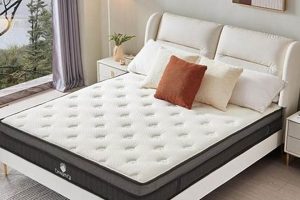
![Best Full Size Orthopedic Mattress [Guide] For Back Pain Organic & Natural Mattress Buyer’s Guide: Non-Toxic Sleep Solutions Best Full Size Orthopedic Mattress [Guide] For Back Pain | Organic & Natural Mattress Buyer’s Guide: Non-Toxic Sleep Solutions](https://mattressworldpa.com/wp-content/uploads/2025/07/th-2835-300x200.jpg)
